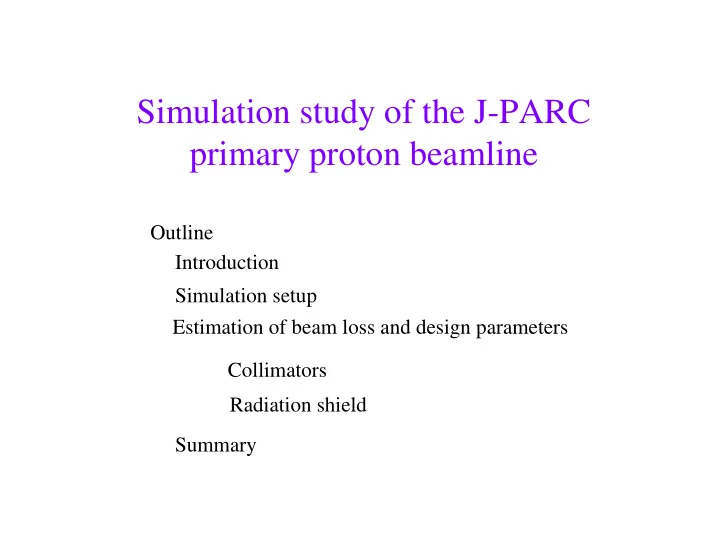

Simulation study of the J-PARC primary proton beamline Outline Introduction Simulation setup Estimation of beam loss and design parameters Collimators Radiation shield Summary
Introduction - J-PARC Neutrino beamline - Proton Beam Power at J-PARC � ~100 times larger than K2K (750 kW) Beam loss induces large radiation dose. (Total Beam loss limit : 1W/m in Arc) The Arc Section consists of super-conducting magnets. Protect the super-conducting magnets from quenching (Line loss limit : 10W/1magnet) PQ1 PQ2A PQ2B PD1 PH2 PH1 1.92 deg. bend P Q 3 A P 2 D P V 1 Q P B 3 1.92 deg. bend B P Q 4 A 50GeV ring H 3 P Q 4 P Q 5 P P V 2 ニ ュ ート リ ノ ・ ビ ーム ラ イ ン Preparation section ~50m Conventional magnet It is very important to reduce the Arc section ~150m Super-conducting magnet beam loss in the arc section in designing the proton beam line. Final Focusing section ~40m 1 Q F 1 H F FQ2A Conventional magnet FQ2B F H 2 F Q 3 A F 3 Q B F Q 4 F V
Collimators and Shield in Preparation Section Beam core: ε =6 [π∗ mm*mrad] , dP/P = 0.3% Acceptance Preparation section : ε =60 [π∗ mm*mrad] Arc section : larger than preparation section To controll the energy deposit in the arc section, the design of the preparation section is important. We have varied the design parameters, and estimated the beam loss in the arc section. Components we studied with simulation Preparation section Beam Collimators Radiation shield at the exit of the preparation section
Simulation Setup with Geant4 Preparation section Beam halo parameter Arc E beam = 50 GeV dP/P = 2.0% ε = 0~200 [π∗ mm*mrad] (uniform distribution in phase space) x’ o r g y d e p i s t e M e V ] [ e n i p r o t o n ] h t [ n u m b e r Final Focus Inject beam halo, estimate beam loss in the arc section. x
Simulated beam loss at each component Preparation section Total beam loss � 750W Arc FF Total loss deposited in components � 3.7W 508W 10 9 energy deposit [MeV] 10 6 10 3 1 100 150 0 50 200 250 orbit length [m] M [ i V ] s t e o g n p e r e y d e n r m b e r ] [ u t o t o n h i p Total beam loss in preparation section is assumed 750W (0.1%). On this assumption, energy deposit in each component were normalized.
Collimator design To protect the Arc magnets from beam loss, collimators in thickness length gap preparation section scrape off the beam halo. gap width beam beam Current design Thickness : 50 cm Fills up as much drift space as Length : 1.45 ~ 3.0 m possible. Gap height : 3.1 ~ 9.5 cm These gap sizes are designed to Gap width : 6.4 ~ 12.1 cm accept particles in ε = 60 [ π * mm * mrad] . � Very large collimators (very conservative)
Collimator design - Thickness of collimators - We checked whether we can make collimators smaller without increase of the beam loss in super-conducting magnets in arc section and conventional magnets in preparation section. PQ3 Magnets around the PV2 collimators at the PQ4 PH3 preparation section PQ5 Energy Deposit [W] 4 Energy Deposit [W] 20 Arc Total Fe Collimator Fe 3 10 W 2 0 0 10 20 30 40 50 60 0 10 20 30 40 50 60 Collimator Thickness [cm] Collimator Thickness [cm] 5cm is thick enough. Calculation result indicates that
Collimator design - Length - We changed the length of collimators. Energy Deposit [W] 6 5 4 3 2 Arc Total 1 0 nominal 10cm 50cm Collimator Length Making collimators shorter increases energy deposit in the arc section. Length of the collimators must be long.
Radiation Shield at the exit of preparation section Tunnel wall In order to protect the super- conducting magnets from shower particles generated in preparation Shield section, radiation shield can be placed at the exit of the preparation showers section. Beamline Assumed shield size : 1m thick, 3m wide (tunnel filler like illustrated in the left figure) ~3 m Arc Preparation section material of shield : concrete, iron or tungsten 1 m
Radiation Shield at the exit of preparation section The inner diameter of the shield : 100mm result is nearly identical with those without shield. smaller the energy deposit in the arc section increased, due (50 or 60mm) to the shower particles generated at the shield. Without Shield Concrete Fe W Energy deposit [W] 15 15 Arc Total @ Arc 1st CF magnet 10 10 5 5 0 0 40 60 80 100 120 40 60 80 100 120 Shield gap size [mm] Shield gap size [mm] The current simulation result does not favor the radiation shield at the exit of preparation section.
Summary We have carried out the J-PARC proton beamline simulation studies. We estimated the beam loss, and studied the design for collimators and radiation shield. Collimator Thickness : 5cm is good enough. length : > 1m needed. Radiation shield at the exit of preparation section The current simulation study does not favor.
Recommend
More recommend